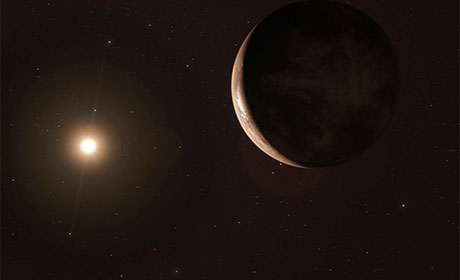“Planet Hunters” Find Terrestrial Planet Near Earth
23 November 2018
Heidelberg astronomers play major role in building CARMENES, a highly complex measuring device

Source: ESO / M. Kornmesser
“Barnard's Star” – the closest single star to the sun – is only six light-years from Earth. Yet it took 20 years for astronomers to reliably detect it. The result of an international research team is based on two elaborate observational campaigns. Instrumental to this success was among others a highly sophisticated measuring device known as CARMENES, and scientists from the Centre for Astronomy of Heidelberg University (ZAH) played a major role in its construction. ZAH researchers also assisted with analysing the observation data from “Barnard's Star”.
The “planet hunter” CARMENES is installed on the 3.5-metre telescope of the Calar Alto Observatory near Almería in southern Spain. Five years in preparation, it was commissioned in November 2015. The sophisticated instrument was designed and built by an international consortium of eleven German and Spanish institutions. It consists of two spectrographs that can analyse the visible and infrared light of astronomical objects. The optical instruments were optimised for discovering planets of nearby stars and most recently helped verify the exoplanet orbiting “Barnard's Star”.
To discover planets, astronomers make use, among other things, of the weak gravitational pull that a planet exerts on its star. They circle each other like figure skaters, with hands extended one towards the other. If one of them is very light, then the heavier one rotates almost exactly on its own axis, although shifted just slightly towards or away from the viewer. Stars with an orbiting planet behave similarly. This movement can be derived through the detection of a periodic shift of dark lines in the star's spectrum. The effects are so tiny, however, that they can only be detected using high-precision instruments.
“Thanks to its sophisticated technology and extremely high stability, CARMENES can measure these small movements,” states Dr Walter Seifert, who is an astronomer at the Königstuhl State Observatory and responsible for the construction of the part of the spectrograph that can measure infrared light. Prof. Dr Andreas Quirrenbach, director of the State Observatory and expert on the search for exoplanets, already predicted in 2015 that CARMENES would discover dozens of planets outside our solar system in the so-called
habitable zone. “The new discovery is surely the most spectacular example,” adds the Heidelberg researcher, who is one of the authors of the “Nature” publication.
“Barnard's Star” was observed nearly every night using CARMENES. The Red Dots observational campaign, which used a network of telescopes to search for planets, also contributed to the discovery. Dr Yiannis Tsapras and Dr Adrian Kaminsky of the ZAH also assisted with analysing the data. In the end, the international team was able to use measurements from seven different instruments over a period of 20 years and a total of 771 measuring points to verify the existence of the planet dubbed “Barnard's Star b”.
Unfortunately, the planet orbits its star at an uncomfortable distance and is likely to resemble a frozen world, according to Prof. Quirrenbach. “However, the results of the method for locating Earth-like planets are promising and leave hope for the discovery of a ‘second Earth’ at some point.” The research results were published in the journal “Nature”.

